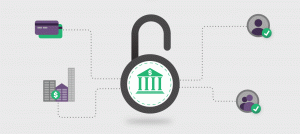
The proliferation of technology is having a significant impact on the banking industry.
Financial institutions are increasingly challenged to adopt digital products in order facilitate the latest trends in consumer behaviour.
A survey published by The Financial Brand reveals the banking industry has been slow to adapt to the digital revolution. Over the past year, the only new focus to make the list of top ten banking trends is the testing of blockchain technology.
Because, surely, there must be more banking trends, then just blockchain?
For instance, last year, CNN reported that 22 global banks initiated the testing of Ripple technology. In all, around 80 banks worldwide have come onboard.
Ripple technology was first developed in 2004. The technology was arguably raw back then, but in the last 14 years, Ripple, together with other blockchain technologies, has shown the potential to create an improved financial system that remedies many of the flaws with the current economic model.
The slow uptake of banks to adopt emerging technologies, however, is part of the problem financial institutions face today.
Hence, we looked at the top ten trends banks are focusing on in 2018 and discusses the potential impact innovation will have on customers.
Top 10 Banking Trends For 2018
#1 Testing Blockchain Technology
According to The Financial Brand, blockchain technology is the only new initiative banks are focusing on in 2018.
If you already know the list from last year, you will not need to read the rest of this article so we are placing blockchain technology at the top.
The overriding purpose of blockchain technology is to create a digital signature that, in theory, should eliminate corruption and other criminal activity together with consumer benefits such as lower transaction fees.
One of the key advantages crypto-commentators rave about is that blockchain technology creates a public ledger that decentralises the financial system.
The big idea is to wrestle the monopoly of power away from a corrupt banking institution.
Of course, the banks will not allow that to happen without a fight. Up until recently, financial institutions and governments resisted blockchain technology.
The question is, now they are trialling it, how much control and influence will financial institutions conquer for themselves?
The blockchain is not for the banks. It is for the benefit of everyone.
It is inevitable the technology will be introduced into the mainstream. However, central banks are refuting cryptocurrencies and are in the process of developing their own digital tokens.
This could have a negative effect on the cryptocurrency market, in particular, ICO’s that have already invested in developing reliable systems that are designed to harbour the best interest of end-users rather than the banks.
Regardless of controls, the blockchain is a disruptive technology that is poised to improve customer experience and enable global trade that reshapes the market.
Nick Bilodeau, the Head of Insurance in Canada for American Express says:
“It has long been anticipated that blockchain will eventually transform the way we transact – largely by automating processing and reducing costs. 2018 will be the year banks get real traction with their blockchain initiatives and when we see banks implement solutions that address areas like KYC, loan fulfilment and cross-border payments.”
Financial markets across the board will be impacted by the development of the blockchain. Government regulations will help to stabilise the market, and savvy investors can expect positive returns.
The greatest challenge for banks is how they will ensure the blockchain is not exposed to cybercriminals and how they can implement a universal system of identity verification that prevents fraud and other criminal activity whilst creating a safe environment for customers in the digital space.
For more detailed information, visit our guide to What Is Blockchain Technology.
#2 Developing Advanced Technologies
The blockchain is not the only technology banks need to integrate into their financial services.
A wave of digital technologies with the potential to improve efficiency and enhance customer experience will disrupt the way people conduct their banking and make financial transactions.
Online banking was only the first step towards this transition. Mobile banking is developing trend banks are struggling to keep up with.
In order to differentiate themselves and become leaders in the digital sphere, financial institutions are vying to become the ‘bank of the future.’
Nicole Sturgil, Principal Executive Advisor at Gartner (formerly CEB) says:
“Financial institutions have spent the last few years painting the vision of what it means to be a digital bank. In 2018, we’ll see a significant shift from optimization streamlining and automation – to creating new revenue streams. This revenue may come from new business models or simply new products and services, but it signals a recognition that simply doing the same things better is no longer enough.”
According to PwC, the ‘essential eight’ digital technologies include:
- The Internet of Things (IoT)
- Artificial Intelligence (AI)
- Robotics
- 3-D Printing
- Augmented Reality
- Virtual Reality
- Drones
- Blockchain
Although it is inevitable that a combination of technologies will become the norm for banks, this “essential” list appears to be geared towards an investor’s mindset rather technologies that are geared towards improving customer services.
However, established technologies have not escaped the attention of banking institutions.
Danny Tang, Channel Transformation Leader of Global Banking at IBM reveals:
“In 2018, chatbots will become mainstream and grow out of the bank-owned channels (e.g., bank’s website, internet banking, mobile banking) and into the conversational platforms customers use most often. These platforms include messaging apps (e.g., Facebook Messenger, LINE, etc) and personal intelligent assistants (e.g., Google Assistant, Amazon Alexa, etc.).”
#3 Adopting Customer-centric Policies
 According to Adweek, a survey of 1500 millennials revealed Generation Y do not trust banks and say financial institutions do not understand them. They would rather lease homes and cars rather than borrow money from banks.
According to Adweek, a survey of 1500 millennials revealed Generation Y do not trust banks and say financial institutions do not understand them. They would rather lease homes and cars rather than borrow money from banks.
While financial institutions have been chiming the need for ‘customer-centricity,’ banks have done little to improve the customer experience.
The overriding consensus is that banks have not invested time or energy into understanding the digital generations.
An 85-page report compiled by Deloitte titled, Improving the Customer Experience in Banking, suggests financial institutions need to evolve in order to meet the needs of modern consumers.
The report suggests banks should:
- Focus on reducing costs and improving the customer experience
- Leverage analytics tools, machine learning and contextual engagement
- Diversify channels to make it easier for consumers to engage with banks
- Be more proactive in the transition advisory and sales activities
- Understand the customer journey and improve end-to-end engagement across various channels
The only banks that received positive feedback for overall customer satisfaction in 2017 primarily attribute their success to improving mobile and online channels.
Mary Beth Sullivan, the Managing Partner of Capital Performance Group says:
“2018 will see a radical change in how traditional financial institutions approach digital transformation. The Chief Digital Officer concept will be replaced as companies seek to embed digital transformation for both customer value proposition and business model transformation into the roles and expectations for every job in the organization and every initiative undertaken. Digital management, much like risk management in recent years, will become an everyone¹s job. This will launch a wave of transformation, especially in traditional banking.”
#4 Increase In Digital Payments
We are beginning to see banks prepare for the transition to digital payment processes.
Banks around the globe are closing down local branches at a fast pace, and online payment facilities such an ApplePay and AliPay are expanding into mainstream forums.
The challenge for banks is to ensure they find the right balance between the number of physical branches available to offline customers and the increase in adoption of digital payments.
While cash remains the principal form of payment for most people around the world, some countries are switching to cashless societies.
India is being used as a testing ground whilst other countries including Singapore, The Netherlands, Sweden and France are gearing towards a digital-only future.
The integration of point-of-sales solutions, dynamic digital wallets, cryptocurrencies, and other value-added services is expected to have a positive impact on merchants and their customers.
However, the reluctance of consumers and retailers to adopt digital payment structure has delayed the transition. For the time being, Stripe has already withdrawn its offering of digital currencies as a means of payment.
While e-payments are expected to grow over the next two years, banks need to do more before consumers feel confident about making the transition to mobile payments, particularly among the less tech-savvy generations.
#5 Rollout of Open Banking
Open banking solutions recently launched in the UK are expected to transform banking for customers and small businesses.
The concept involves the ability to use the services of multiple financial institutions from one central interface.
The foundation of integrated partnerships will mean consumer data is spread across several databases. The challenge for banks and FinTech firms is how to pull all this data together in order to better understand customers.
The adoption of blockchain technology provides the ideal solution.
Application Programming Interfaces (API’s) are not new to banks, and as financial service providers allow for the migration between partners, traditional banking platforms will be transformed to meet the demand of greater digital solutions.
#6 Multichannel Delivery
Moving away from face-to-face contact means banks will have to provide customers with improved digital options. A failure to orientate banking services across multiple platforms could pose the biggest threat to how banks deliver customer satisfaction and advance loyalty programs.
Modern consumers want convenience and with the growth of digital technologies expectations are at a premium. Three years ago, consumers were quick to adopt online and mobile banking.
A lack of functionality and issues surrounding security measures has seen interest in m-payments tail off at the start of 2018.
This year, banks will begin to realise the importance of FinTech companies.
#7 Partnerships with FinTechs
Up until recently, financial institutions had regarded FinTechs as nothing more than a nuisance.
The Global Fintech Report published by PwC revealed 88% of legacy banking organisations fear a loss of revenue by handing over the reins to companies with more advanced technologies.
Meanwhile, 30% of consumers plan to increase their use of digital solutions.
Now, disruptive technology is beginning to show its worth in the digital age, FinTech has lit a flame of innovation under the hob of banking evolution.
As a result, banks are looking to collaborate with FinTech firms in order to develop intuitive products, improve ease of use and provide 24/7 accessibility.
Partnering with FinTech is the only option banks have to alleviate consumer issues and keep pace with the demands of an evolving landscape.
#8 Regulation Changes
With the introduction of digital technologies, and the growing interest in cryptocurrencies, new banking regulations need to be established and 2018 will be the year when we see countries around the world shepherd in new laws on digital transactions.
For the time being, lawmakers are not expected to make definitive changes to the existing mechanics. Blockchain technology resolves most of the issues anyway.
The biggest change will be to ensure that digital transactions are not anonymous.
Bryan Clagett, CMO of Geezeo says:
“The complexities and nuances of data management, privacy and security will come to a head for financial institutions and fintech. Both will need to assure data platforms are designed around the principles of transparency and trust, as governments role in oversight continues to evolve.”
The good news for businesses and individuals are that online banking regulations make sense.
There are deliberate links between business strategy and building an infrastructure that can be used for governance, regulatory reporting and risk management.
One of the countries working on the regulations between emerging technologies and the current financial systems is Malta – the Government has released the first proposal for cryptocurrency and blockchain regulatory framework.
#9 FinTech v Tech Giants
While FinTechs such as WeChat, AliPay, Monzo and N26 have paved the way for a smoother transition into the digital era, established tech giants have the financial clout, mass customer base and experience of expanding their corporate brands into banking.
Household names such as Microsoft, IBM, Google, Facebook and Amazon have already made in-roads to navigate the switch to digital channels.
What’s more, these firms are establishing payment gateways and earning consumer trust which could pose a threat to traditional banking institutions.
Unless banks adopt digital technologies that satisfy the demands of consumers, we could witness a decline of conventional banking facilities.
An upsurge in the choice of digital currencies created by companies independent of banking institutions is being backed by investors.
Save for government regulations stunting the growth of ICO’s, consumers will have the option to choose between the old firm or the new guard.
#10 Identity Fraud and Improved Security
One of the biggest challenges for banks is to ensure they can identify their real customers against the fake ones without compromising customer experience.
Despite the obvious benefits with regards convenience and lower transaction fees offered by online banking and mobile payments, the digital arena is more vulnerable to cyber attacks and identity fraud.
Cybercrime is also the biggest concern for digital customers, and whilst consumer confidence is growing on digital platforms, the emergence of sophisticated technologies and increase in reports of cybercrime remain a concern.
Overall
The solution for banks is to roll-out tools powered by artificial intelligence.
The focus for 2018 is to ensure financial institutions collect clean and usable data and build solid foundations that enable them to better identify fraudulent activity on customer accounts.
As financial institutions step up efforts to accommodate the digital revolution, these are the top ten banking trends we can expect to see filtered in over the course of 2018 and beyond.
How long do you think it will be before the world is fully digital?
And, if you want to find out more about the Top Trends For FinTech.



![Bitcoin Buyer Review of Official Website [2022] bitcoin buyer review featured image](https://bitemycoin.com/wp-content/uploads/2022/04/bitcoin-buyer-review-featured-218x150.jpg)
![Bitcoin Digital | Official Website Review [2022] bitcoin digital review featured](https://bitemycoin.com/wp-content/uploads/2022/04/bitcoin-digital-featured-218x150.jpg)







